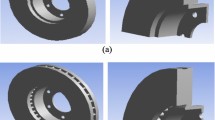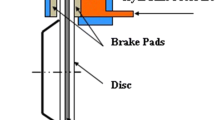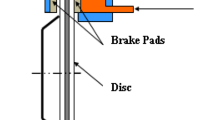Abstract
The braking phenomenon is an aspect of vehicle stop** performance where with kinetic energy due to speed of the vehicle is transformed to thermal energy via the friction between the brake disc and its pads. In our work, we presented numerical modeling using ANSYS software adapted in the finite element method, to follow the evolution of the global temperatures for the two types of brake discs, full and ventilated disc during braking scenario. Also, numerical simulation of the transient thermal and the static structural analysis were performed sequentially, with coupled thermo-structural method. Numerical procedure of calculation relies on important steps such that the Computational Fluid Dynamics and thermal analysis have been well illustrated in 3D, showing the effects of heat distribution over the brake disc. This CFD approach helped in the calculation of values of the heat transfer coefficients (h) that have been exploited in 3D transient evolution of the brake disc temperatures. Three different brake disc materials were tested and comparative analysis of the results was conducted in order, to derive the one with the best thermal behavior. Finally, the resolution of the coupled thermomechanical model allows us to visualize other important results of this research such as; the deformations, and the equivalent Von Mises stress of the disc, as well as the contact pressure of brake pads. Following the analysis of the results obtained, we draw several conclusions from this investigation. The choice allowed us to deliver the excellent rotor design to ensure and guarantee the good braking performance of the vehicles.





















Similar content being viewed by others
References
N. Elabbasi, J.W. Hong, K.J. Bathe, On the reliable solution of contact problems in engineering design. Int. J. Mech. Mater. Des. 1, 3–16 (2004)
K. Pejhan, A. Kuznetcov, Q. Wang, C.Q. Wu, I. Telichev, Design assessment of a multiple passenger vehicle component using load transfer index (U*U*) method. Int. J. Mech. Mater. Des. 14(2), 213–229 (2018)
M.H. Hajiyan, S. Mahmud, M. Biglarbegian, H.A. Abdullah, A new design of magnetorheological fluid based braking system using genetic algorithm optimization. Int. J. Mech. Mater. Des. 12(4), 449–462 (2016)
P.L. Tso, R. Hsu, Estimating chemical mechanical polishing pad wear with compressibility. Int. J. Adv. Manuf. Technol. 32, 682–689 (2007)
N.Y. Nguyen, Z.W. Zhong, Y.B. Tian, Analysis and improvement of the pad wear profile in fixed abrasive polishing. In. J. Adv. Manuf. Technol 85, 1159–1165 (2016)
C.C.A. Chen, Q.P. Pham, Study on diamond dressing for non-uniformity of pad surface topography in CMP process. Int. J. Adv. Manuf. Technol. 91, 3573–3582 (2017)
S. Hasagasioglu, K. Kilicaslan, O. Atabay, A. Güney, Vehicle dynamics analysis of a heavy-duty commercial vehicle by using multibody simulation methods. Int. J. Adv. Manuf. Technol. 60, 825–839 (2012)
M.A. Ashraf, B. Sobhi-Najafabadi, Ö. Göl, D. Sugumar, Numerical simulation of sliding wear for a polymer–polymer sliding contact in an automotive application. Int. J. Adv. Manuf. Technol. 41, 1118–1129 (2009)
P.M. Lerones, J.L. Fernandez, J.G. Garcıa-Bermejo, E. Zalama, Total quality control for automotive raw foundry brake disks. Int. J. Adv. Manuf. Technol. 27, 359–371 (2005)
A. Belhocine, N.M. Ghazaly, Effects of Young’s modulus on disc brake squeal using finite element analysis. Int. J. Acoust. Vib. 31(3), 292–300 (2016)
M.R. Ishak, A.R. Abu Bakar, A. Belhocine, J.M. Taib, W.Z. Wan Omar, Brake torque analysis of fully mechanical parking brake system: theoretical and experimental approach. Ing. Invest. Tecnol. 19(1), 37–49 (2018)
J.H. Choi, I. Lee, Transient thermoelastic analysis of disk brakes in frictional contact. J. Therm. Stress 26(3), 223–244 (2003)
J.H. Choi, I. Lee, Finite element analysis of transient thermoelastic behaviors in disk brakes. Wear 257(1–2), 47–58 (2004)
Y. Yildiz, M. Duzgun, Stress analysis of ventilated brake discs using the finite element method. Int. J. Automot. Technol. 11(1), 133–138 (2010)
M. Duzgun, Investigation of thermo-structural behaviors of different ventilation applications on brake discs. J. Mech. Sci. Technol. 26(1), 235–240 (2012)
M. Pevec, Prediction of the cooling factors of a vehicle brake disc and its influence on the results of a thermal numerical simulation. Int. J. Automot. Technol. 13(5), 725–733 (2012)
P. Hwang, X. Wu, Investigation of temperature and thermal stress in ventilated disc brake based on 3D thermo-mechanical coupling model. J. Mech. Sci. Technol. 24(1), 81–84 (2010)
M.J. Han, C.H. Lee, T.W. Park, S.P. Lee, Low and high cycle fatigue of automotive brake discs using coupled thermo-mechanical finite element analysis under thermal loading. J. Mech. Sci. Technol. 32(12), 5777–5784 (2018)
M.J. Han, C.H. Lee, T.W. Park, J.M. Park, S.M. Son, Coupled thermo-mechanical analysis and shape optimization for reducing uneven wear of brake pads. Int. J. Automot. Technol. 18(6), 1027–1035 (2017)
P. Dufrénoy, D. Weichert, Prediction of railway disc brake temperatures taking the bearing surface variations into account. Proc. Inst. Mech. Eng. F J. Rail 209(2), 67–76 (1995)
J. Reimpel, Braking Technology (Vogel Verlag, Würzburg, 1998)
P.F. Gotowicki, V. Nigrelli, G.V. Mariotti, D. Aleksendric, C. Duboka, Numerical and experimental analysis of a pegs-wing ventilated disk brake rotor with pads and cylinders, in 10th EAEC Eur. Automot. Cong. Paper EAEC05YUAS04–P5 (2005)
M.K. Khalid, M.R. Mansor, S.I. Abdul Kudus, M.M. Tahir, M.Z. Hassan, Performance investigation of the UTeM eco-car disc brake. Int. J. Eng. Technol. 11(6), 1–6 (2011)
R. Limpert, Brake Design and Safety, in 2nd Edition, Warrendale (Society of Automotive Engineering Inc., Pennsylvania, 1999), p. 137–144
T.J. Mackin, S.C. Noe, K.J. Ball, B.C. Bedell, D.P. Bim-Merle, M.C. Bingaman, D.M. Bomleny, G.J. Chemlir, D.B. Clayton, H.A. Evans, Thermal cracking in disc brakes. Eng. Fail. Anal. 9(1), 63–76 (2002)
G. Oder, M. Reibenschuh, T. Lerher, M. Šraml, B. Šamec, I. Potrč, Thermal and stress analysis of brake discs in railway vehicles. Adv. Eng. 3(1), 95–102 (2009)
Theory reference for ANSYS and ANSYS Workbench, ANSYS Release 11, ANSYS Inc., (2007)
A.R. Abu Bakar, H. Ouyang, L.C. Khai, M.S. Abdullah, Thermal analysis of a disc brake model considering a real brake pad surface and wear. Int. J. Veh. Struct. Syst. 2(1), 20–27 (2010)
N. Coudeyras, Non-linear analysis of multiple instabilities to the rubbing interfaces: application to the squealing of brake, Ph.D. Thesis, Central school of Lyon-speciality: mechanics, December (2009)
A. Stephens, Aerodynamic Cooling of Automotive Disc Brakes, Master’s thesis. School of Aerospace, Mechanical and Manufacturing Engineering, RMIT University, March (2006)
Author information
Authors and Affiliations
Corresponding author
Ethics declarations
Conflict of interest
The authors declare that there is no conflict of interest.
Additional information
Publisher's Note
Springer Nature remains neutral with regard to jurisdictional claims in published maps and institutional affiliations.
Rights and permissions
About this article
Cite this article
Belhocine, A., Abdullah, O.I. Thermomechanical Model for the Analysis of Disc Brake Using the Finite Element Method in Frictional Contact. Multiscale Sci. Eng. 2, 27–41 (2020). https://doi.org/10.1007/s42493-020-00033-6
Received:
Revised:
Accepted:
Published:
Issue Date:
DOI: https://doi.org/10.1007/s42493-020-00033-6




